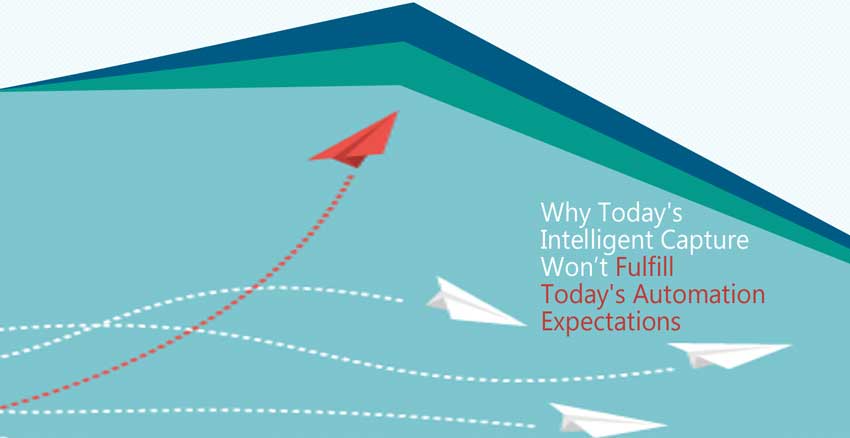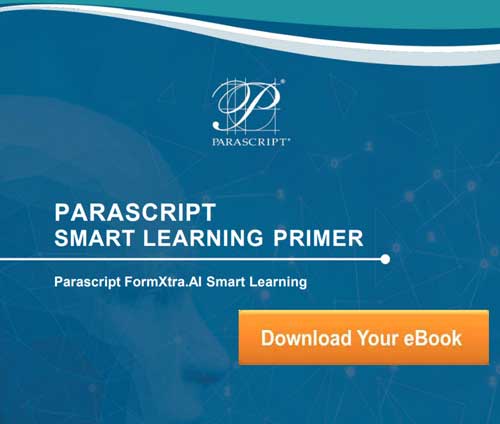Today’s Intelligent Capture won’t fulfill today’s expectations for automation. In the last several years, we have witnessed a renewed enthusiasm around re-engineering processes to make them more customer-centric, adaptable and efficient. A lot of this momentum is driven by a bevy of new or renewed capabilities revolving around AI and automation that are starting to deliver on promises made long ago of enabling truly digital, autonomous organizations.
Through use of these new and evolved capabilities, processes are able to be transformed and can be initiated, processed and completed with little to no human involvement. As a result, customers receive quicker and more precise interactions while the organizations servicing them have improved adaptability and insight into processes enterprise-wide with lower costs.
Automation: Intelligent Capture
One area of automation that has not done a good job of keeping-up is Intelligent Capture. This area is involved with automating the tasks of organizing and granting access to unstructured data, often document-based, that is needed to run and complete all sorts of processes. Intelligent capture in general has done a good job of automating these organization and data entry tasks, which has reduced a good amount of workload while speeding-up processes.
But today’s and tomorrow’s automation needs are increasingly in the area of fully-autonomous processes that minimize or mitigate the need for tedious human involvement. And the reality is that today’s Intelligent Capture solutions cannot often deliver that.
Imagine a future where autonomous vehicles are on the road, but instead of alleviating the need for passengers having to attend to navigate to their destination, watching out for the various hazards along the way, passengers are required to check and verify every single action the autonomous vehicle plans to make. Sure, there is automation at the decision-making level, but not at the level that really reduces work. That scenario would prevent any level of adoption. It is exactly that scenario that the vast majority of organizations adopting Intelligent Capture are in today.
Intelligent Capture: Check and Verify
Why is checking and verifying every Intelligent Capture result necessary? There are two main reasons:
- There is no ability to automatically verify the results of Intelligent Capture with third-party data. There are some use cases where automated verification can occur such as with an invoice processing workflow where data located and extracted on an invoice can use accounting system data to perform checks automatically. However, these cases are relatively uncommon due to the likelihood of differences in how two or more parties format the data.
- Absent a reliable third-party data store for automated verification, another mechanism must be used. This is one that few Intelligent Capture solutions support and if they do support it, it’s so complex and costly to implement, that it rarely gets used. That mechanism is the confidence score and confidence threshold. All solutions that work with data output have them. And yet, the reality is that, while many have heard of a confidence score, few organizations understand clearly how to use it. And worse, many Intelligent Capture solutions do not produce confidence scores reliable enough to use.
Automation Without Straight Through Processing
The result is that the majority of organizations may be benefiting from automation of data entry, but they have to check every single answer. This means that the expectation of creating a fully-automated process falls well short of being realized. Automation projects that rely upon document-based information end up dealing with manual verification bottlenecks or processes that can involve enough staff to work around the clock.
Intelligent Capture Straight Through Processing
There is hope, however. Curiously enough, the answer also deals with automation: automation of the configuration and management of the system itself by using special-purpose machine learning (ML). The ML software knows how to deal with document-based information and can produce and analyze reliable data.
The result is that 80% or greater of the data entry tasks that are automated can flow straight through. While not quite 100% human-free processes, the ability to achieve a high rate of straight through processing for the majority of the data entry tasks means organizations can get much closer to the goal of quick, efficient automated processes.
The ability to achieve a high rate of straight through processing for the majority of the data entry tasks means organizations can get much closer to the goal of quick, efficient automated processes.
Parascript has been providing highly-automated data entry for over 25 years and takes great efforts to ensure that the systems we build are intelligent enough to discern good data from bad. And with Smart Learning, the ability to support highly-tuned, highly-automated document processing just got a lot easier.
###
If you found this article interesting, you may want to check out the Smart Learning (AI) Primer eBook that provides an overview of how Smart Learning supports automated document processing meeting today’s automation expectations.





